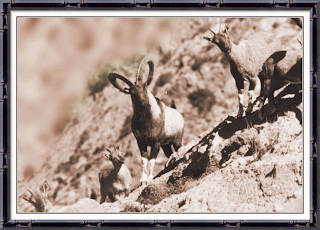"Kabul Markhor" Provincial Animal of Khyber Pakhtunkhwa:
The Kabul Markhor or Straight-horned Markhor (Capra falconeri megaceros) is goat-antelope native toPakistan. it is the Provincial animal of Khyber Pakhtunkhwa.Markhor are adapted to mountainous terrain, and can be found between 600–3,600 meters in elevation. Markhor are diurnal, and are mainly active in the early morning and late afternoon. Their diet shifts seasonally: in the spring and summer periods they graze, but turn to browsing in winter, sometimes standing on their hind legs to reach high branches. Markhor live in flocks, usually numbering nine animals, composed of adult females and their young.
"Kalij Pheasant" Provincial Bird of Khyber Pakhtunkhwa:
Kalij Pheasant, Lophura leucomelanos, is a pheasant found in forests and thickets. Males have a total length of 63 to 74 centimetres (25 to 29 in) and females 50 to 60 centimetres (20 to 24 in).In the males of the first group most of plumage is glossy blue-black, though with white to the rump or underparts in most subspecies, and in hamiltoni, the westernmost subspecies, the crest is white (all other have a blue-black crest). In the second group, the underparts and crest are glossy blue-black, but the tail and upperparts are white (or very pale grey) with most feathers densely vermiculated with black.Females are brownish. In some subspecies the underparts are distinctly marked in whitish and black, while in others most feathers are pale-edged, resulting in a scaly appearance.
"Juniperus Squamata" Provincial Tree of Khyber Pakhtunkhwa:
Juniperus squamata is a species of juniper. It grows at 1,600-4,900 m altitude. It is a shrub (rarely a small tree) reaching 2-10 m tall (rarely 15 m), with flaky brown bark, and a prostrate to irregularly conical crown. The leaves are broad needle-like, 3-9 mm long, arranged in six ranks in alternating whorls of three, and often strongly glaucous blue-green in colour. The cones are berry-like, globose to ovoid, 4-9 mm long and 4-6 mm diameter, glossy black, and contain one seed; they are mature in about 18 months. The male cones are 3-4 mm long, and shed their pollen in early spring. It is largely dioecious, with pollen and seed cones produced on separate plants, but occasionally monoecious.
"Morina" Provincial Flower of Khyber Pakhtunkhwa:
Morina is a genus of the angiosperm family Morinaceae. It is the provincial flower of the Khyber Pakhtunkhwa province of Pakistan. Morina is named in honor of Louis-Pierre Morin (1635–1715), a french physician and botanist.
Peshawar is the capital of Khyber-Pakhtunkhwa,and the administrative center and central economic hub for the Federally Administered Tribal Areas of Pakistan. Peshawar is situated in a large valley near the eastern end of the Khyber Pass. Known as "City on the Frontier", Peshawar's strategic location on the crossroads of Central Asia and South Asia has made it one of the most culturally vibrant and lively cities in the greater region. Peshawar is irrigated by various canals of the Kabul River and by its right tributary, the Bara River.Peshawar is the major educational, political and business center of Khyber Pakhtunkhwa.
















































